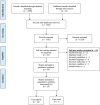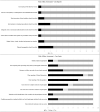Pregnancy and Neuromyelitis Optica Spectrum Disorder - Reciprocal Effects and Practical Recommendations: A Systematic Review
- PMID: 33178102
- PMCID: PMC7596379
- DOI: 10.3389/fneur.2020.544434
Pregnancy and Neuromyelitis Optica Spectrum Disorder - Reciprocal Effects and Practical Recommendations: A Systematic Review
Abstract
Introduction: Neuromyelitis optica spectrum disorder (NMOSD) is an inflammatory disorder of the central nervous system characterized by severe, antibody-mediated astrocyte loss with secondary demyelination and axonal damage, predominantly targeting optic nerves and the spinal cord. Recent publications have alluded to increased disease activity during pregnancy, and adverse maternal and fetal outcomes in patients with NMOSD. Our objective was to systematically review published literature to help counsel and manage women with NMOSD contemplating pregnancy. Methods: We searched five databases including MEDLINE and EMBASE, for English-language publications describing pregnancies in women with NMOSD. Article selection, data extraction, and risk-of-bias assessment using Joanna Briggs' critical appraisal tool for case reports and case series, were performed in duplicate. Pooled incidences were calculated where possible, and a narrative summary was provided. Results: Of 2,118 identified titles, 22 case reports and seven case series, representing 595 pregnancies in 389 women, were included. The mean maternal age was 28.12 ± 5.19 years. At least 20% of cases were first diagnosed during pregnancy. There were no maternal deaths. Pooled estimates for clinical outcomes could not be obtained due to inadequate reporting. NMOSD-related disability and relapses increased considerably during pregnancy and especially in the immediate postpartum period. Although a high proportion of early pregnancy losses were reported, an association with disease activity or therapeutic interventions could not be established. Apart from one publication which reported an increased risk of preeclampsia, there was no increase in adverse obstetric outcomes including preterm birth, fetal growth restriction or congenital malformations. Initial attacks and relapses were successfully managed with oral or intravenous corticosteroids and immunosuppressants, and refractory cases with immunoglobulin, plasma exchange and immunoadsorption. Conclusion: Increased NMOSD-related disability and relapses during pregnancy the postpartum period may respond to aggressive management with corticosteroids and immunosuppressants such as azathioprine, which are safely administered during pregnancy and lactation. Emerging safety data on monoclonal antibodies during pregnancy, make these attractive options, while intravenous immunoglobulin, plasma exchange and immunoadsorption can be safely used to treat severe relapses. The complex interplay between NMOSD and pregnancy outcomes would be best understood through prospective analysis of data collected through an international registry. Disclosure: Dalia Rotstein has served as a consultant or speaker for Alexion and Roche. She has received research support from Roche Canada. Rohan D'Souza has served as a consultant and speaker for Ferring Canada Inc and Ferring Global Inc, on topics unrelated to this manuscript. The other authors have no relevant relationships to disclose.
Keywords: devic syndrome; maternal and fetal risks; neuromyelitis optica spectrum disorder; pregnancy; systematic review.
Copyright © 2020 D'Souza, Wuebbolt, Andrejevic, Ashraf, Nguyen, Zaffar, Rotstein and Wyne.
Figures
Similar articles
-
Efficacy and tolerability of azathioprine for neuromyelitis optica spectrum disorder: A systematic review and meta-analysis.Mult Scler Relat Disord. 2019 Aug;33:22-32. doi: 10.1016/j.msard.2019.05.011. Epub 2019 May 22. Mult Scler Relat Disord. 2019. PMID: 31136907
-
[Neuromyelitis optica spectrum disorder and pregnancy].Nervenarzt. 2018 Jun;89(6):666-673. doi: 10.1007/s00115-018-0486-4. Nervenarzt. 2018. PMID: 29383411 Review. German.
-
Neuromyelitis optica spectrum disorders and pregnancy: relapse-preventive measures and personalized treatment strategies.EPMA J. 2018 Aug 10;9(3):249-256. doi: 10.1007/s13167-018-0143-9. eCollection 2018 Sep. EPMA J. 2018. PMID: 30174761 Free PMC article. Review.
-
Neuromyelitis Optica Spectrum Disorder: Clinical Burden and Cost of Relapses and Disease-Related Care in US Clinical Practice.Neurol Ther. 2021 Dec;10(2):767-783. doi: 10.1007/s40120-021-00253-4. Epub 2021 May 27. Neurol Ther. 2021. PMID: 34046846 Free PMC article.
-
Neuromyelitis Optica (Devic's Syndrome): an Appraisal.Curr Rheumatol Rep. 2016 Aug;18(8):54. doi: 10.1007/s11926-016-0599-3. Curr Rheumatol Rep. 2016. PMID: 27402111 Review.
Cited by
-
Analysis of Pregnancy-Related Attacks in Neuromyelitis Optica Spectrum Disorder: A Systematic Review and Meta-Analysis.JAMA Netw Open. 2022 Aug 1;5(8):e2225438. doi: 10.1001/jamanetworkopen.2022.25438. JAMA Netw Open. 2022. PMID: 35925605 Free PMC article.
-
Insights into neuromyelitis optica spectrum disorder and pregnancy from a single-center study in Thailand.Sci Rep. 2025 Feb 1;15(1):4011. doi: 10.1038/s41598-025-88624-x. Sci Rep. 2025. PMID: 39893222 Free PMC article.
-
International Delphi Consensus on the Management of AQP4-IgG+ NMOSD: Recommendations for Eculizumab, Inebilizumab, and Satralizumab.Neurol Neuroimmunol Neuroinflamm. 2023 May 31;10(4):e200124. doi: 10.1212/NXI.0000000000200124. Print 2023 Jul. Neurol Neuroimmunol Neuroinflamm. 2023. PMID: 37258412 Free PMC article.
-
Neuromyelitis optica spectrum disorder safely and successfully treated with satralizumab during pregnancy and breastfeeding: a case report.Front Neurol. 2023 Dec 15;14:1322412. doi: 10.3389/fneur.2023.1322412. eCollection 2023. Front Neurol. 2023. PMID: 38162440 Free PMC article.
-
Review of the Longitudinal Management of Autoimmune Encephalitis, Potential Biomarkers, and Novel Therapeutics.Neurol Clin Pract. 2024 Aug;14(4):e200306. doi: 10.1212/CPJ.0000000000200306. Epub 2024 May 29. Neurol Clin Pract. 2024. PMID: 38831758 Free PMC article. Review.
References
-
- Glisson C. Neuromyelitis Optica Spectrum Disorders. In: Gonzalez-Scarano F, JF D. eds. Waltham, MA: UpToDate; (2020).
Publication types
LinkOut - more resources
Full Text Sources



